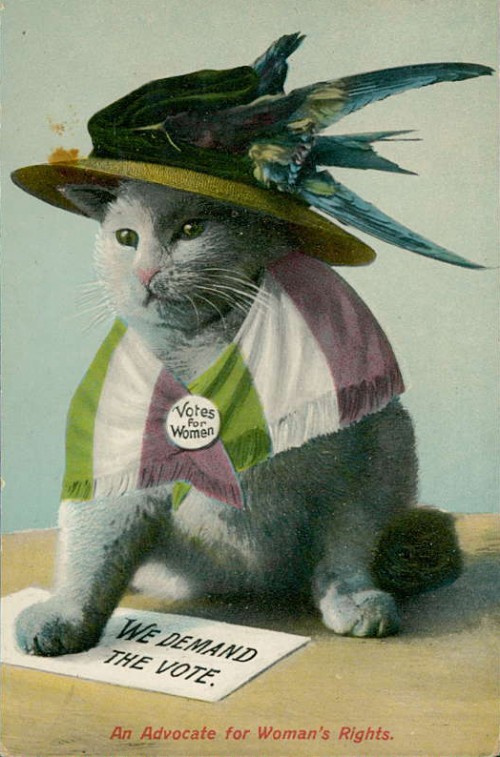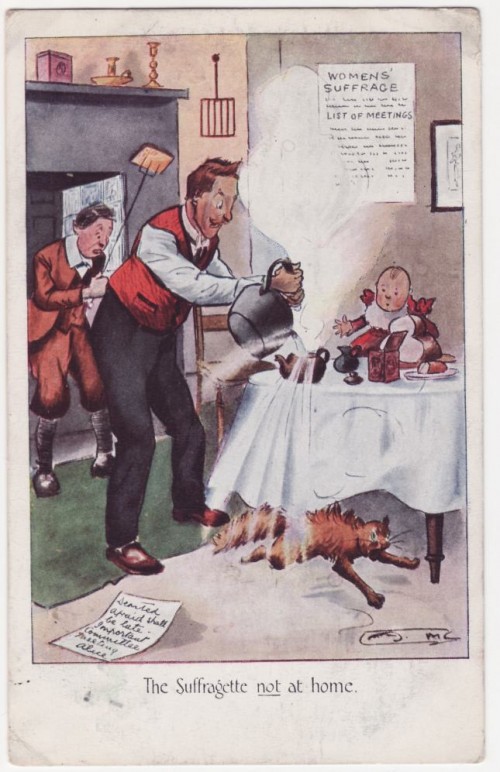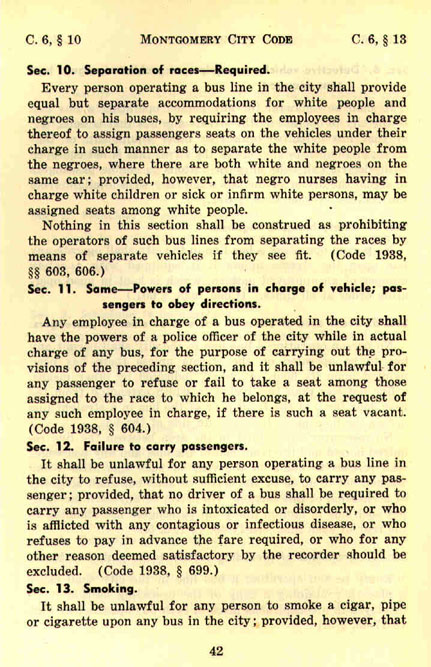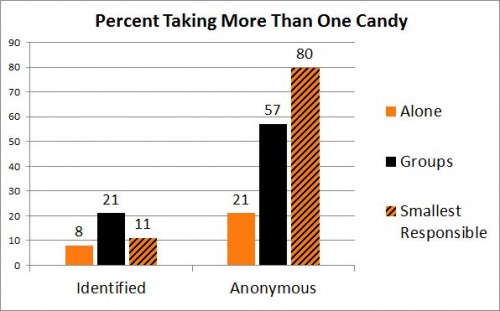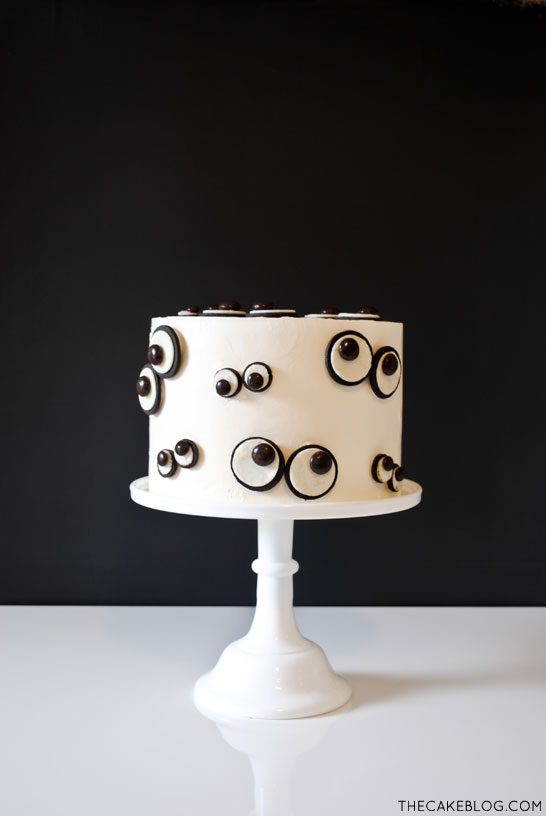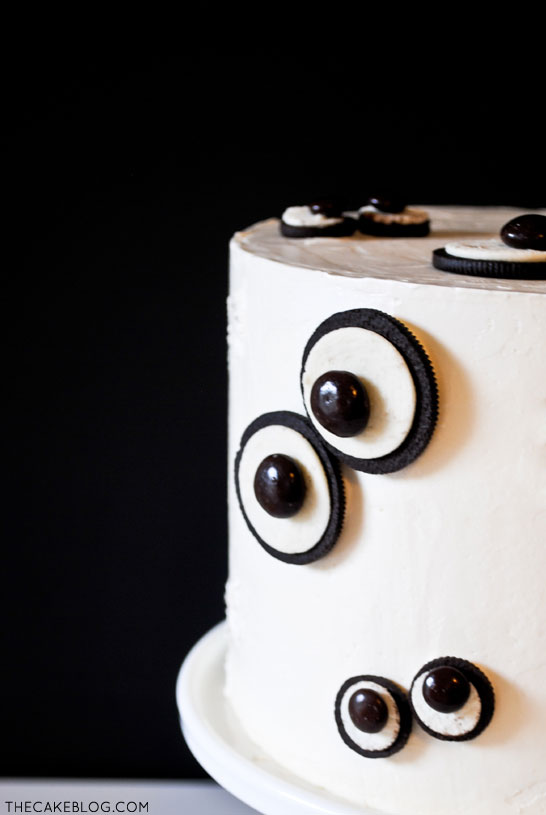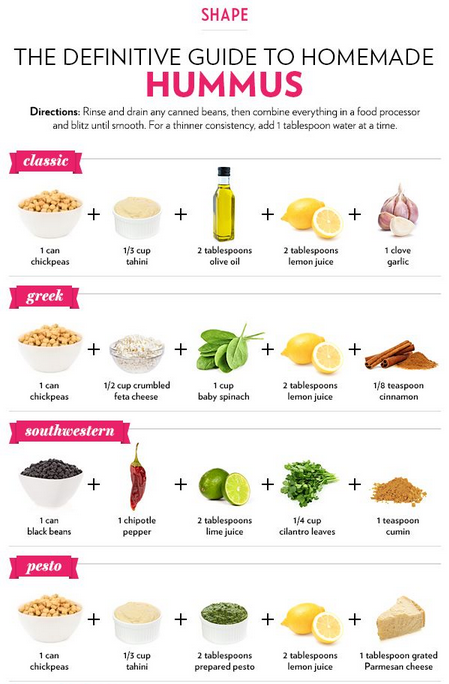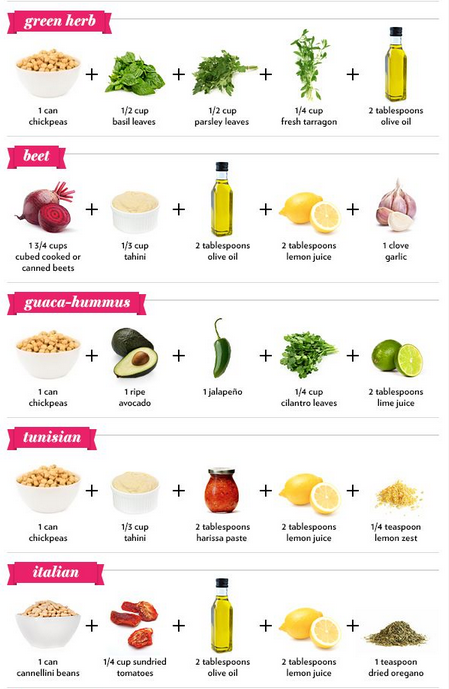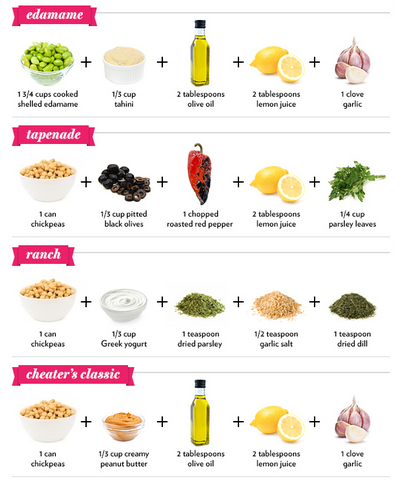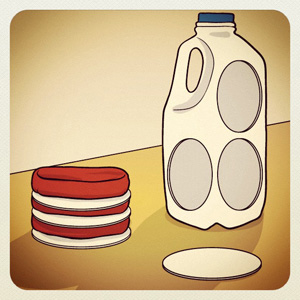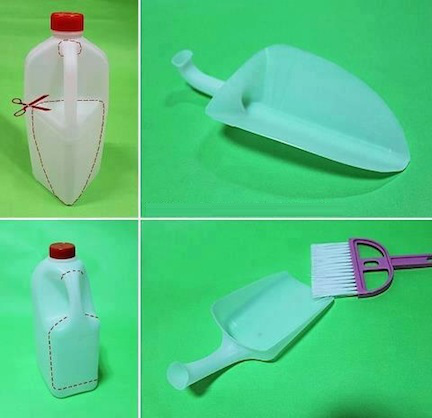Shared posts
Can I Wear Drawstring Pants To The Office?
December 12, 2013

Thank you all so much. I'm sitting in an airport with a dying battery, but seriously, I have not felt so unstressed in a long time. More on this later, promise!
December 10, 2013

Just a reminder, only 5 days left to get an SMBC thing by Christmas AND we're down to about 40 SCIENCE books. Thanks, geeks!
Woman-as-Cat in Anti-Suffrage Propaganda
Cats and dogs are gendered in contemporary American culture, such that dogs are thought to be the proper pet for men and cats for women (especially lesbians). This, it turns out, is an old stereotype. In fact, cats were a common symbol in suffragette imagery. Cats represented the domestic sphere, and anti-suffrage postcards often used them to reference female activists. The intent was to portray suffragettes as silly, infantile, incompetent, and ill-suited to political engagement.
Cats were also used in anti-suffrage cartoons and postcards that featured the bumbling, emasculated father cruelly left behind to cover his wife’s shirked duties as she so ungracefully abandons the home for the political sphere. Oftentimes, unhappy cats were portrayed in these scenes as symbols of a threatened traditional home in need of woman’s care and attention.
While opposition to the female vote was strong, public sentiment warmed to the suffragettes as police brutality began to push women into a more favorable, if victimized, light.
As suffragettes increasingly found themselves jailed, many resisted unfair or inhumane imprisonment with hunger strikes. In response, jailers would often force-feed female prisoners with steel devices to pry open their mouths and long hoses inserted into their noses and down their throats. This caused severe damage to the women’s faces, mouths, lungs, and stomachs, sometimes causing illness and death.
Not wanting to create a group of martyrs for the suffragist cause, the British government responded by enacting the Prisoner’s Act of 1913 which temporarily freed prisoners to recuperate (or die) at home and then rearrested them when they were well. The intention was to free the government from responsibility of injury and death from force feeding prisoners.
This act became popularly known as the “Cat and Mouse Act,” as the government was seen as toying with their female prey as a cat would a mouse. Suddenly, the cat takes on a decidedly more masculine, “tom cat” persona. The cat now represented the violent realities of women’s struggle for political rights in the male public sphere.
The longevity of the stereotype of cats as feminine and domestic, along with the interesting way that the social constructions flipped, is a great example of how cultural associations are used to create meaning and facilitate or resist social change.
Cross-posted at Jezebel and Human-Animal Studies Images.
Ms. Wrenn is an instructor of Sociology with Colorado State University, where she is working on her PhD. She is a council member of the American Sociological Association’s Animals & Society section and has published extensively on the non-human animal rights movement.
(View original at http://thesocietypages.org/socimages)
Holiday Treats on the Today Show
| Picture by Nancy Hopkins |
 |
| Filling balls! Hangin' with the wonderful Nancy on set! The whole Today Show gang come to check out the treats. |
| This is what the December Better Homes and Gardens cover looks like. YOU CAN'T MISS IT! |
| My cart waits in a hotel lobby. It gets a lot of attention from passersby. |
| This is Allie. She's on the Today Show team, making all the food segments flawless before the cameras start rolling. |
| Coconut Snowballs!! |
| Hidden Snowman...not so hidden anymore, are you? |
| Sparkly pinecones. |
| Gingerbread Snow Village |
| Peppermint Swirl Marshmallows |
Perfect Christmas Present Idea: Awkward Moments Children’s Bible
Ok, so this may be more for the kid at heart than your actual kids, but if you love the Bible (or are just aware of its existence) and you’ve got a sense of humor, then this may be the perfect Christmas present for you or for one of your friends…to give you.
It’s called the Awkward Moments (Not Found In Your Average) Children’s Bible – Vol. 1.
I’ve only seen these pictures that my friend Kristen Howerton over at Rage Against the Minivan shared with me, but if the rest of the book is as amazing as these pages, then sign me up for volume 2 and every other volume that ever comes out.
The basic gist of the book, if you haven’t figured it out already (but of course you have ‘case you’re smart like that), is that all those awkward, disturbing Bible stories we usually gloss over or ignore altogether (like David collecting foreskins from his conquered enemies) are finally shown the love heretofore only revered for stories like Noah’s ark.
As you might expect the results are pretty hilarious.
So enjoy this little preview and when your done, do yourself a favor and pick up a copy of this awesome book today.
Official Documents from the Arrest of Rosa Parks
Fifty eight years ago today, Rosa Parks kicked off a plan to bring down Jim Crow segregation by refusing to move to the back of the bus. @ShawneeSoc sent us a link to the Washington Post, where they featured her original arrest documents. A very cool piece of history.
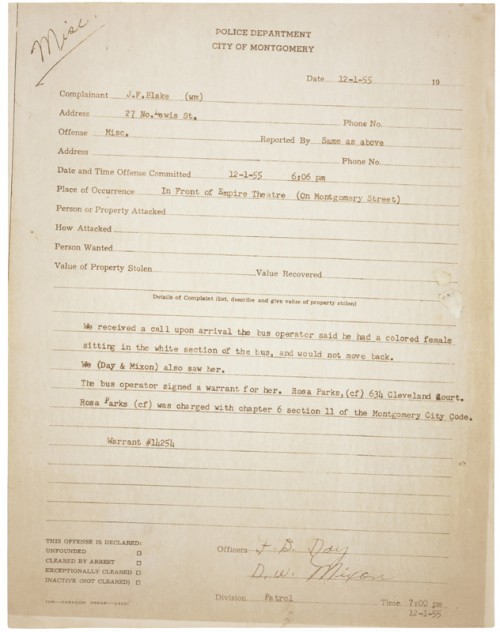
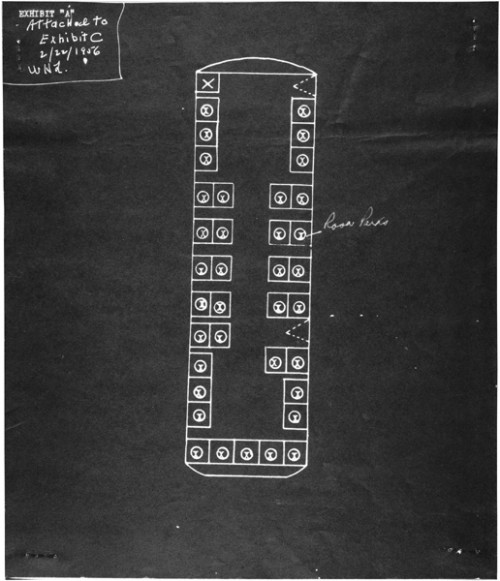 Bonus, here’s the law that Parks was arrested for violating and an explanation (thanks to Martín A. for the link):
Bonus, here’s the law that Parks was arrested for violating and an explanation (thanks to Martín A. for the link):
Lisa Wade is a professor of sociology at Occidental College. You can follow her on Twitter and Facebook.
(View original at http://thesocietypages.org/socimages)
Tired of Hearing about Obamacare? Turn Off Fox.
Yesterday the Pew Research Center released data on the news coverage of Typhoon Haiyan — a disaster that has killed at least 4,000 people — and the bungled Obamacare website roll-out. Comparing 20 hours of news coverage over four major U.S. channels, they found dramatic differences. The data below shows the hours and minutes spent on each topic at each channel (red = Obamacare, yellow = the typhoon).
First, the two partisan channels (Fox News and MSNBC) gave more time to Obamacare than the typhoon. On MSNBC, there was four times as much coverage of Obamacare. On Fox, there as a stunning 80 times as much coverage. Al Jazeera America and CNN spent significantly more time on the typhoon, likely reflecting their more global focus and less of an ideological mission.
The channels also differed in how much time they spent on facts/reporting versus opinion/commentary. Check it out:
While most all of us sometimes lazily refer to “the media” as if it’s a homogeneous thing, it’s important to remember that our perceptions of reality are strongly shaped by which media we consume.
Lisa Wade is a professor of sociology at Occidental College. You can follow her on Twitter and Facebook.(View original at http://thesocietypages.org/socimages)
SharePoint Online introduces the Touch Design mobile experience
Mark Kashman (@mkashman) is a senior product manager on the SharePoint team.
With the new SharePoint we brought important innovations for how users interact with SharePoint sites and content on mobile devices: contemporary views, device channels, and new native apps (SkyDrive Pro apps and SharePoint Newsfeed apps). From the start, touch has been a key area of investment across all of the products in the new Office, and SharePoint is no exception. Now we're making SharePoint even more touch friendly.
The new Touch Design mobile pages enhance the touch experience of two core SharePoint components, SkyDrive Pro and Sites. Now, when you access SharePoint Online from smaller devices-from 11-inch screens down to 4-inch-you have a new app-like experience that enables you to work your best with your documents and team sites.
Office 365 business users will see the new Touch Design pages over the next few week as we roll out worldwide.

The Touch Design view of "my documents" in SkyDrive Pro on an 11-inch touch tablet device.

Backstage of the Touch Design experience on a 11-inch screen showing navigation access to Office 365 tiles.
See the lists of supported mobile device browsers in SharePoint 2013.
Let's take a closer look at how the Touch Design pages work.
SharePoint Online and the new Touch Design experience
Touch Design creates new and improved mobile browser views and experiences for SkyDrive Pro and Sites in Office 365. The app-like design, with documents displayed as big touchable tiles on the screen, was first introduced with the recently announced OWA for iPhone and iPad. With the new Touch Design pages in SkyDrive Pro and Sites, you touch tiles to view your documents, documents shared with you, or documents you follow. You can also open documents or share the URL of a document with other users using touch.
After reviewing a document or site, the next action you might want to take is share. So we made it super easy to share documents. To share a document, simply tap the share icon in the upper right (as pictured below), and then enter the recipient's email address, the level of access (view or edit) you want to provide, and whether you require sign-in. This is the same external sharing process that has been of great value to Office 365 customers since we launched Office 365.

You can share a document (internally or externally) from the backstage view in Touch Design. To open the backstage, tap the ellipsis next to the document.
The new Touch Design pages will load by default on most devices. If you're working on a Surface or other Windows tablet, Windows Phone, an iPhone or iPad, or an Android phone or tablet, when you land on SkyDrive Pro or Sites, the new Touch Design interface automatically appears.
Navigation
Once signed in, you can switch between SkyDrive Pro and Sites by tapping the navigation icon in the bottom left corner of the page. You may also see tiles for other components of Office 365 you subscribe to: mail, calendar, and contacts.

Tap the icon in the lower left to access the backstage, which shows tiles you can tap to reach SkyDrive Pro or Sites.
Touch Design scales to smaller devices
Touch Design was developed to scale to the optimal experience on smaller devices, from 11-inch devices down to 4-inch screens. The user experience is exactly the same for pages displayed on devices smaller than 11 inches as it is for pages displayed on 11-inch devices, which we described above. You have the same access to your documents and sites on smaller devices, too.
Here's how Touch Design looks like on a 4-inch screen when you perform four common actions.


Backstage of the Touch Design experience on a 4-inch screen showing navigation access to Office 365 tiles. After clicking into the SkyDrive Pro tile, you see a "shared with me" documents pivot.


After clicking into the
SkyDrive Pro tile, you see a "followed" documents pivot. After clicking into the Sites
tile, you see a list of sites you're following.
You are more mobile than ever and now your SharePoint Online investments are, too
Today's announcement brings greater touchability to core SharePoint destinations in Office 365-SkyDrive Pro and Sites-across your devices. And there's more to come. Fingers ready...set...GO!
Thanks.
--Mark Kashman, @mkashman
FAQ
Q: Which Office 365 plans will receive the new Touch Design mobile pages?
A: The new Touch Design mobile pages are now available for all Office 365 for business users. Specifically, these plans are: Office 365 Small Business (P1), Office 365 Small Business Premium (P2), Office 365 Midsize Business, Office 365 Enterprise E1, E3, and E4, Office 365 Education A2, A3, and A4, Office 365 government G1, G3, and G4, and Office 365 Enterprise E3 for Nonprofits.
Q. Does this announcement apply to Office 365 dedicated subscribers?
A. No. The Office 365 dedicated plans are not receiving this same update at this time, because they are managed in a unique, isolated infrastructure.
Q. Does this announcement apply to customers who have deployed SharePoint 2013 on-premises?
A. No. This update applies only to the Office 365 service instance of SharePoint Online.
The Delusional Followers of Convicted Felon Jack Schaap
The Re-Victimization of Homosexual Targets of the Nazi Regime
A hundred thousand men and women identified as homosexuals were imprisoned during the Nazi regime. They were detained under a law known as “paragraph 175,” which made sodomy illegal. Up to 15,000 were sent to concentration camps instead of prisons. Nearly 2/3rds would die there. The last surviving victim is believed to have died in 2011.
These men and women were not only victims of Nazi Germany, surviving torture in concentration camps, they were also denied validation as victims of the Third Reich. They were classified as criminals upon release and included on lists of sex offenders. Some were re-captured and imprisoned again.
The world went on to mourn the inhumanity of the Holocaust, but not for them. Because they were designated as non-victims, and also because they were stigmatized sexual minorities, they were largely excluded from the official history of Hitler’s Germany.
Seeking to give these men and women a voice, historian Klaus Müller interviewed several gay men and one lesbian around the year 2000. At the time, there were fewer than 10 left alive. Not one of the men and women imprisoned for being homosexual — alive or dead — had ever been officially identified as a victim of the Nazi regime.
The documentary, titled Paragraph 175, is one of the most heart-wrenching I’ve ever seen. For some, it sounds as if this is the first time anyone — even members of their own family — has ever asked them about what happened. Re-telling the stories of death and torture is obviously incredibly painful, as it would be for any survivor.
On top of this, however, is anger at their extended invisibility and continued oppression. Many seem opposed to talking about it at all, saying that it’s too painful to re-live, but it is as if they can’t help it; they are at the end of their lives and facing, perhaps, their first and last chance to do so. In the interviews, the anger, pain, survivor guilt, and relief mix together. It’s excruciating.
I was riveted, even as I desperately wanted to look away so as to avoid the emotions it brought out in me. I can’t recommend it strongly enough.
Lisa Wade is a professor of sociology at Occidental College. You can follow her on Twitter and Facebook.(View original at http://thesocietypages.org/socimages)
Jesus, Darth Vadar, And 9/11
Some things leave just leave me speechless.
This would be one of them.
My friend over at Christian Nightmares found it. If the painting love at first sight for you, you can bid on a copy of it over at ebay.
But be warned, you might have to cough up a good bit of change. Apparently the original version sold for $800.
Classic American Salt-Rising Bread
Have you heard of salt-rising bread?
Probably not, if you’re neither a passionate bread baker, nor a resident of certain parts of the country – the southern and western portions of the Appalachians, western New York down into western Pennsylvania, and parts of Michigan. This traditional American bread remains popular in these regions, where it’s often sold in bakeries.
But if you’re living in, say, Colorado, or Connecticut? You probably never heard of salt-rising bread.
So let me describe it to you: it’s a fairly dense, fairly moist, very close-grained white bread, with a distinctive “cheese-y” flavor. It makes wonderful toast. But its most salient characteristic? It’s not made with yeast. And, contrary to its name, it doesn’t rely on salt for rising; in fact, this bread has less salt than many standard breads.
So what’s the deal?
Salt-rising bread had its American origins back in the early 1800s, when commercially produced yeast wasn’t available. Housewives found that a mash of cornmeal and milk (and/or potatoes) could produce a bubbly substance that could then be used to raise bread.
The “starter” was tricky, though, needing consistent warmth to work; it’s thought that perhaps “salt-rising” refers to the rock salt that pioneer women might have heated and piled around their starter, to keep it warm.
These days, those of us experimenting with salt-rising bread find ourselves with the same challenge as our forebears: how to keep the starter warm for the 12 to18-hour, two-stage process it needs to leaven bread.
Heating pad, top of the fridge, near the wood stove, over a heating grate… all of these are imperfect solutions. (I know, I’ve tried them.)
But now, I’ve found the perfect tool for not just salt-rising bread, but all kinds of yeast breads, plus sourdough starter and yogurt, too.

This “climate controlled” electric proofer offers temperature settings from 70°F-120°, plus a water tray for optimum humidity. If you’re a baker who struggles to find a cozy place in the house for rising bread or feeding sourdough (or salt-rising starter and bread), you might consider this tool.
But don’t worry; while this proofer makes the whole process a lot simpler, I’ve found another “hot spot” in my house; and it’s hopefully one that’ll work for you, too.
If you’ve never made salt-rising bread, please be prepared to trust me through some of the following procedures. Yes, it’s very important to keep the starter warm. Yes, it’s supposed to smell that way. The bread’s aroma is redolent of cheese, though there’s no cheese in involved; the flavor comes from the slight fermentation of the ingredients during the bread’s preparation.
Speaking of fermentation, be prepared; the starter and dough will smell like… dirty socks? Old sneakers mixed with Parmesan cheese? Somewhat unpleasant, anyway, but please bear with me – it’s just the enzymes and bacteria doing their jobs and giving the bread its special qualities. If you’ve ever made cheese or yogurt, you know exactly what I’m talking about.
OK, let’s get started here, shall we? This bread is built in stages. First stage: starter #1.
Heat 1/4 cup milk (skim, 1%, 2% or whole) until it’s nearly but not quite boiling; small bubbles will form around the edge of the pan (or microwave container), and you might see a bit of steam. This is called “scalding” the milk.
Cool the milk until it’s lukewarm, then whisk together the milk, 2 tablespoons cornmeal (yellow is traditional), and 1 teaspoon sugar in a small heatproof container. The container should be large enough to let the starter expand a bit.
A note on cornmeal: while you can certainly use “supermarket” cornmeal, organic is probably preferable, since it comes with additional “friendly bacteria.”
Cover the container with plastic wrap, and place it somewhere warm, between 90°F and 100°F. The bread proofer mentioned above is ideal for this, since you can set the exact temperature you want.
I find my turned-off electric oven, with the light turned on for about 2 hours ahead of time (and then left on throughout the starter’s time in the oven) holds a temperature of 95°F to 97°F, perfect for this starter.
I tried a heating pad covered by an overturned bowl, but it didn’t work. Before you even start this process, find someplace reliably warm for the starter; if you can’t find someplace that’ll stay warm for up to 12 hours at a time, it’s best not to try this recipe.
Let the starter rest in its warm place overnight, or for 8 to 12 hours.
The starter won’t expand much, but will develop a bubbly foam on its surface. It’ll also smell a bit fermented. If it doesn’t bubble at all, and doesn’t smell fermented, your starter has failed; try again, using different cornmeal, or finding a warmer spot.
Next, we’ll build on this first starter; let’s call this starter #2.
Combine the following:
1 cup hot water (120°F to 130°F)
1/2 teaspoon salt
1/2 teaspoon baking soda
1/2 teaspoon sugar
Add 1 1/2 cups (6 1/4 ounces) King Arthur Unbleached All-Purpose Flour, stirring until everything is thoroughly moistened.
Stir starter #1 into starter #2.
Cover the bowl with plastic wrap, and place it in the same warm spot starter #1 was in. Let it rest until very bubbly and doubled in size, 2 to 4 hours.
Success!
If the starter’s not showing any bubbles after a couple of hours, move it somewhere warmer. If it still doesn’t bubble after a couple of hours, give it up; you’ll need to start over.
If the process isn’t working for you, don’t be too discouraged; even our pioneer forebears found this bread notoriously fickle, working perfectly one day, not so well another. Personally, I think it’s all about finding a spot that’s reliably warm, between 90°F and 100°F.
Transfer your bubbly starter to a larger bowl, or the bowl of a stand mixer (or your bread machine bucket).
Add the following:
4 tablespoons soft butter
1/2 teaspoon salt
2 1/4 to 2 1/2 cups (9 1/2 to 10 1/2 ounces) King Arthur Unbleached All-Purpose Flour
Start with the smaller amount of flour. In the depths of summer, when your kitchen is hot and humid, you may need to use more. But usually you’ll only need about 2 1/4 cups to make a dough that’s cohesive and elastic yet still a bit sticky, as pictured above.
Hey, what’s with the salt being added after the dough was already partially kneaded, you ask? Simple; I forgot to add it when I added the butter and flour. Good lesson: when you forget an ingredient in yeast bread dough (including the yeast), simply knead it in when you remember.
In fact, sometimes you forget the yeast and only realize it when your dough doesn’t rise. Go ahead and knead the yeast into that unresponsive lump of dough, and give it an hour or so; it should be fine.
OK, back to business. Knead everything until smooth; this took 7 minutes at medium speed in my stand mixer. The dough will be soft, and fairly elastic/stretchy.
Shape the dough into a log, and place it in a lightly greased 8 1/2″ x 4 1/2″ loaf pan.
Cover the pan, and place it back in its warm spot. Let the loaf rise until it’s crowned about 1/2″ to 3/4″ over the rim of the pan, which could take up to 4 hours or so.
This won’t form the typical large, domed top; it will rise straight up, with just a slight dome.
Towards the end of the rising time, preheat the oven to 350°F.
Bake the bread for 35 to 40 minutes, until it’s nicely browned. Again, it won’t rise much; that’s OK.
Remove the bread from the oven; if you have a digital thermometer, it should read about 190°F to 200°F at its center. Wait a couple of minutes, then turn it out of the pan onto a rack to cool.
Run a stick of butter over the bread’s surface, if you like; this will add flavor, and a lovely golden sheen.
Here comes the hard part: DO NOT slice the bread until it’s completely cool! You’ll make the loaf gummy if you do. And after all you’ve been through to get to this point, you surely don’t want impatience to get the better of you now.
Once it’s cool – enjoy! Toast it. Use it for sandwiches. Make grilled cheese. This bread keeps quite well at room temperature for 5 to 7 days; if there’s any left over after that, it’s best to wrap it tightly and stow it in the freezer.
Salt-rising bread can be quite a journey; but the end result is well worth it, in my book. Partly because I feel good keeping alive a very old tradition; and partly because, hey, who doesn’t like cheese-y bread?
Please read, bake, and review our recipe for Classic American Salt-Rising Bread.
Print just the recipe.
5 Reasons Packages Get Destroyed
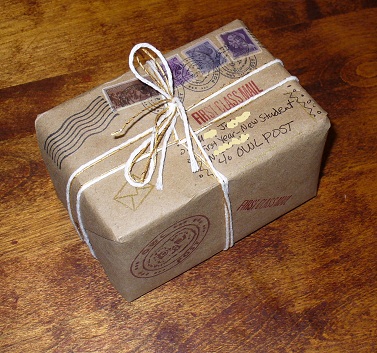
[Courtesy]
Here’s an interesting article on 5 Reasons Packages Get Destroyed, as written by a former UPS worker.
Apparently writing “fragile” on a package might mean postal workers treat it more roughly, but it might work to “Camouflage It as a Heartwarming Gift.” From the article:
My default is to curse every package that comes down that slide. Anything that sticks out is going to brighten my day. So if you want your package handled a little more tenderly, give it to your small child (or a friend’s child — anyone’s child will do) and let them write on it in crayon.
See, I’m not about to smash a package that belongs to some kid. I see all the crayon scribbles and poorly spelled adulation for mom, or grandpa, or whoever the hell, and all I can picture is a toddler sending his beloved teddy bear to grandma on the raisin ranch because she only has days to live. And I’ll be goddamned if I’ll let anything happen to that teddy! Maybe you aren’t allowed within a certain distance of small children. That’s fine; just make the package look like a gift. Some stickers, “Happy Birthday” written on it, whatever. As long as it’s enough to create a heartwarming story to make us care a little more.
Got it. Write the address in crayon, maybe avoid this?
My Travel Medicine Kit (and How We Stay Healthy on the Road)
Written by Stephanie Langford
I’m continually grateful for this kit.
Each time I pull it out to treat someone’s sickness or owie or to find something to give our systems a boost, I do so with a huge sense of relief at having something so thorough along for this ride-of-our-lives adventure we find ourselves on each day.
Having the peace of mind that comes from carrying a wide array of natural remedies and medicines as we travel is worth its weight in gold. Naturally, the medicine kit I created for us weighs a ton (and resides in my husband’s bag, which I’m sure he loves).
As we prepared to embark on a round-the-world trip for one year, I knew we would visit many places where health care is less accessible, and that finding the necessary medications or ingredients for natural remedies would be difficult indeed.
I began to draw up my list of supplies many months in advance, wanting to be prepared for as many possible situations as I could, while recognizing that I could never be prepared for everything.
Many of you have asked about our medicine kit, and so I’m going to walk you through it and tell you why I’ve included each item.
Tinctures
A sweet friend helped me out in the last month or two before our departure by making all of these tinctures with herbs I had purchased, but not yet had time to do anything with. Every time I use them, I'm grateful to her for helping us to get ready to go!
Calm/Sleep – To help calm and relax us when anxious or having difficult sleeping in new time zones.
Elderberry/Rosehip – Our primary cold/flu fighting remedy.
Echinacea/Goldenseal – As an immune booster when sick or fighting infection.
Vitamin/Mineral - An everyday vitamin and mineral boost, because sometimes it's hard to get everything our bodies need, and the stress of traveling can make us need even more than usual.
Other remedies
Liquified clay (in tube) – For bug bites! If you’ve never tried a clay paste rubbed onto an itchy, irritating bug bite, you don’t know what you’re missing. We also use this on cuts and scrapes, on skin irritations, on ingrown toenails (yes, this works!), etc. My kids know to ask for the clay right away with any sort of bite.
Powdered clay – We keep the powdered stuff for digestive upsets, or occasionally we’ve used it for baths, but we don’t really have a large enough supply to be able to use it that way. If someone gets an upset stomach, diarrhea, has been throwing up, etc. we feed them small amounts of clay water. It helps to absorb and remove whatever is causing the problem. Read more about the wonders of clay here.
Arnica gel- For bumps and bruises. It helps to reduce pain, and I find that it really reduces the severity of bruising after a fall.
Herbal salve – This is our go-to for almost everything skin related. Diaper rash, cuts and scrapes, chapped lips, rashes, bug bites that get red.
People’s Paste- This powdered mix is comprised of slippery elm, bayberry, garlic, cayenne, and comfrey. This is a remedy I hadn’t tried prior to our trip, but wanted to have because it sounded so useful (I read about it in Be Your Own Doctor). The idea is that it has potent herbs in it for preventing infections and promoting wound healing, but it also has the slippery elm which binds the skin together to help prevent scarring and to use when stitches are needed but not available.
Essential oils
- Tea Tree – For infections, for homemade fruit & veggie wash, and a ton of other things.
- Lavender – For relaxation, for burns, for cleaning, perfect for de-stinking a bad hotel room that your child threw up in (yes, it worked enough to allow me to sleep afterwards).
- Peppermint – For stomach upsets, for sore/tight muscles, for headaches.
- Eucalyptus – For congestion, for sore muscles.
- Clove - For pain, for teething, for parasites.
- Serenity blend from DoTERRA – For sleep and relaxation. I usually just use this for me, once again, for my struggles with sleep. This particular blend works really, really well for me.
The fractionated coconut oil is for diluting oils before use, but unfortunately it opened up and mucked up my bag within our first couple weeks of travel. So much for that one! Since then, I've just used a bit of olive oil for diluting.
Past Tense (doTERRA) for headaches – You have to use these essential oil headache remedies early enough in the headache (before they turn into a migraine or splitting headache) but if you do, they make a huge difference and can often make the headache go away. Since most of me and my husband’s headaches come from tension in our necks and backs, sometimes we rub the oil there as well, and that works even better.
MotionEaze (not pictured here)- This is an essential oil blend that is meant to help with motion sickness. You put a drop behind each of your ears. It isn’t a perfect solution for those who are truly prone to motion sickness (which I and both of my daughters are, and my sons to a lesser extent), but I do find that it helps. You can use it both before you begin to travel, and once you’re already feeling sick.
Lympha Rub – From TriLight Health, this is a blend of essential oils intended for rubbing on lymph nodes at the first sign of sickness, to aid the lymphatic system in flowing smoothly and not getting clogged up, which can help to either prevent or shorten the duration of sickness.
Cod Liver Oil- The one major supplement I was insistent on bringing with us. It’s heavy, and it has to be packed carefully, but it’s a supplement I didn’t want us to spend a year without. Read why I’m such a strong believer in CLO here. I also believe that the high vitamin A content is what helped all 4 of our kids to get through a bout of measles with absolutely no complications and to bounce back very well afterwards.
Melatonin - Mostly for me. I struggle a lot with sleeping well, particularly when I’m overtired, have jet lag, am in new situations, on airplanes/trains/ferries, etc.
Calcium/Magnesium capsules- I found I was getting recurring migraines, 1-2 per week about halfway through our trip. Though we eat as well as we can, I wondered whether I was getting as much cal/mag as I needed, so I started taking this and the migraines have definitely decreased in frequency.
Activated charcoal tablets – These can also be used similarly to the clay, for things like food poisoning, diarrhea, etc. I’ve also successfully used charcoal to help treat an infection, and I would use it for a more serious bug bite, like a spider bite. Clay might work, too, but I just know that charcoal is great at removing toxins in those situations.
Probiotics – I brought some capsules for myself, as when we went on the trip I was still recovering from about a month of dealing with a horrible tonsilar abscess, and I had been hospitalized and received antibiotics since it was so serious (it has to be serious for me to consider antibiotics, because they’re a drug to be taken seriously). I was still trying to pump my system back up. But later, we realized that we needed probiotics to help protect our digestive systems as we traveled around and were exposed to different kinds of bacteria, viruses, parasites, etc.
Actual medicines (yes, we brought some of these along)
- Children’s ibuprofen – In case of high fevers that wouldn’t break (we rarely use anything to artificially bring down fevers because I firmly believe they are an important natural bodily response to infection or illness, but in some instances, if I couldn't get medical care and the fever was high enough or lasted long enough, I would use this).
- Antibiotic ointment – In case of infected wounds that my natural measures weren’t dealing with fast enough.
- Round of heavy-duty antibiotics - For me, as an emergency measure in case I get a recurring tonsil abscess, which I have had twice in the past 3 years, so I am at high risk for another one, and they require a doctor’s care.
- Motion sickness preventative pills - I’ve only used them once, when I got really sick on a ship in the Mediterranean, but I keep them on hand just in case.
- Malaria medication and worm treatment- I am also considering getting a round of both malaria treatment, as well as worm treatment, from a local pharmacy with the help of my friend here that is a midwife while we're here in Africa. She suggested, and I agree with her, that they would be good things simply to have on hand in case we needed them quickly.
Other good stuff for your run-of-the-mill cuts, scrapes, splinters, etc.
- Long tweezers
- Large pack of multi-sized bandaids, which I had replenished once during the trip
- Several large gauze bandages
- Medical tape
- Special blister bandaids (which we've never used to date)
- Digital thermometer
- Triclosan-free anti-bacterial wipes from CleanWell (we have the spray version, too). These are perfect for helping to prevent exposure to unknown germs and bacteria, especially in some of the less sanitary places we visit.
Things we added while on the road
Vitamin C powder – I didn’t seek this out, but my mother-in-law left it behind after she spent 3 weeks with us in the summer, and I’m so grateful for it. About halfway through the trip, I noticed that our wounds were not healing as well as they used to and so I’ve begun to add extra vitamin C as often as I remember, and we’ve also used it to help deal with a round of colds/flus that we had in Africa.
Black walnut power – I asked my MIL to bring this with her in the summer, because I was concerned that we may be beginning to have parasite buildup. There weren’t symptoms of this with anybody but myself at the time, but I wanted to have it nonetheless. I used this, along with wheatgrass juice powder, clove oil, probiotics and vitamin C to do a bit of a parasite cleanse while we were living in Israel and I felt like my gut was handling things MUCH better after I did it.
Kids parasite/bacteria treatment – As we prepared to head into Africa and India in particular, I picked up this Chinese herbal treatment at a health food store in Tel Aviv. Wouldn’t you know, our kids all got sick with diarrhea or vomiting our first week in Africa? I was so happy I had this!
Malaria prevention/treatment tinctures – Specifically for Africa, this is a series of tinctures that are not quite on the market but beginning to be used by a lot of missionary families and in some initial trials in Uganda, I believe, and they’re proving effective. They include a prevention, treatment, and then follow-up tincture. We weren’t particularly keen on the malaria medications available and really wanted to use something different. We got them from Mountain Meadow Herbals.
Papaya Leaf Tea – I bought this before we left and had my MIL bring it when she visited. I had done some research on papaya leaf as a prevention for mosquito-born blood infections like malaria and dengue fever. Apparently something in the papaya leaf changes the blood so that the infections cannot take root and grow. We started taking it several weeks before getting to malaria zones, continue to take it while here (we're in Africa at the moment), and will finish it up in the weeks after we leave.
Wheatgrass juice powder – My MIL left this after her trip as well, and I’ve used it to do a parasite cleanse for myself, and also sometimes serve it (though truthfully, I’m the only one who takes it very willingly) just as a health boost or when I’m lacking in energy.
Common ingredients I use when I can find them
- Raw honey – Mostly for making cough & cold syrup.
- Olive oil – Sometimes I infuse fresh garlic in the oil, and I also use it as a carrier oil for my essential oils.
- Coconut oil – Same as the olive oil, but also use it as a moisturizer, diaper cream, anti-fungal treatment, etc.
- Fresh garlic- We use this constantly because it of it’s anti-viral, anti-bacterial properties, for infections, colds and flus in particular.
- Onions - for congestion and especially to make my cough syrup
- Ginger or ginger powder
What I wish I had
- Emergen-C - for heat stroke and treating dehydration (instead, I've been making a rehydration drink using sugar or honey, along with some salt)
- Zinc tablets
- Herbal lozenges (it’s really hard to find ones that aren’t full of sugar, or else chemical sweeteners, which we avoid like the plague).
Storing and carrying it all-- my big, black medicine kit
I searched high and low on the internet for just the right bag. I wanted it to have multiple sizes and shapes of see-through, zippered compartments, and to all fold up into one smooth and easily portable carrying bag.
This Travelon Flat-Out Toiletry Kit from Amazon fit the bill.
The only glass that we have are very strong, tempered glass in the form of tincture bottles and essential oil bottles. Any liquids are packaged first in a Ziploc bag, before being zipped up into the plastic compartment. Essential oils have probably been the worst for leaking if someone put them away with the lid not on extremely tight, but overall we haven’t had any major issues with leaking or breakage.
8 1/2 months in to our trip, and even though it's taken a beating, this kit is still in excellent condition. The pictures in this post were just taken this week, and you can see that it's still looking great!
And that's my medicine kit! Nice and light, right?
Well, nobody ever said I was a minimalist. But our kit is helping us to stay healthy as we travel, and treat almost all of our illness and ailments on our own, regardless of where we are or what happens.
What would you bring in a travel medicine kit?
Disclaimer: Although all of the Keeper of the Home writers are passionate about natural health, none of us are medical professionals. This post is for entertainment and educational purposes only. This post includes both affiliate and referral links to products that our family personally uses and recommends. We earn a small commission when you purchase through our links, which helps to keep this site going, so thank you!
We love our sponsors:
- Plan to Eat: Plan To Eat was born from our desire to eat real food — great food — prepared at home, together as a family. Plan to Eat is an online menu planner that uses your recipes, scheduled for the days you want them, automatically generating your grocery list, organized the way you like to shop. Eat well. Eat together. PlanToEat.com.
The post My Travel Medicine Kit (and How We Stay Healthy on the Road) appeared first on Keeper of the Home.
Comments
- i've been waiting for this post. I wonder how much I can adapt ... by renee @ FIMBY
- This is such a fantastic list, and I love that there are even ... by Cait
- Hi Stephanie, EXCELLENT INFORMATION.... I always travel with a ... by Cynthia
- This is great! I have almost everything you listed here along ... by Mare @ just-making-noise
- Thank you so much for sharing! We will be traveling to Uganda ... by Jen
- This is great! So much useful information! I would also add ... by Camilla
Related Stories
The Psychology of Greed on Halloween
It turns out, there’s a nice Halloween field experiment. Here’s the setup. On Halloween, a woman answers the door and invites the trick-or-treaters in. She tells them to “take one,” and then leaves the room leaving the bowl of candy and a bowl of nickels and pennies (adjusting for inflation: dimes and quarters, maybe even half-dollars). They did this experiment at 27 houses with a total of 1,300 kids.
Overall, most kids (69%) took one. But conditions mattered.
In one experimental manipulation, the woman either asked the kids who they were and where they lived or she allowed them to be anonymous. Experimenters also noted whether the kids were trick-or-treating alone or in groups. For some groups, the woman designated the smallest kid in the group as being in charge of making sure that kids took only one. All these variables made a difference.
The greatest rate of cheating (80%) occurred when the smallest child was being responsible but everyone was anonymous. Diener reasoned that with responsibility shifted to the smallest link, the other kids would feel freer to break the rule.
Those who did cheat usually took only an additional one to three candies. But, of those who did grab more than what was offered, 20% took both candy and coins. Unfortunately, the Snickers study is not like the marshmallow study, so we don’t know where those greediest kids are now.
HT: PsyBlog. Cross-posted at Montclair SocioBlog.
Jay Livingston is the chair of the Sociology Department at Montclair State University. You can follow him at Montclair SocioBlog or on Twitter.(View original at http://thesocietypages.org/socimages)
College Photoshops Black Man’s Head into Marketing Material… Again
UPDATE: I may have been wrong about this one and, if so, I apologize. The Univ. of Alabama has released a statement saying that the image is not photoshopped, including a quote from the student saying “It’s kind of funny, but people are blowing it out of proportion a little bit.” If anyone has further information on this story, please email it to socimages@thesocietypages.org.
In 2000, the University of Wisconsin – Madison was sued by a man named Diallo Shabazz. Because the college wanted to present itself as a diverse place, Shabazz, a black man, had been featured in university marketing materials for several years. That year, however, his face was photoshopped into a picture of a crowd at a football game. He complained, but was blown off. He’d had enough. In his lawsuit, he asked not for a settlement, but for a “budgetary apology”: money dedicated to increasing the actual diversity of the campus.
Today @EricTTung sent us another example of this kind of doctored diversity, currently the first slide on the homepage of the University of Alabama. Do you see it?
How about now?
Note the skin color of the African American man’s hands.
As I’d written in the post about Shabazz, this teaches us both that colleges believe that diversity is a useful commodity with which to market their institutions and that, “if real diversity isn’t possible, cosmetic diversity will do.”
Lisa Wade is a professor of sociology at Occidental College. You can follow her on Twitter and Facebook.Recruitment of minorities to a mostly white campus: tricky. Addressing the systematic educational underinvestment in minorities prior to arriving: expensive. Retaining minorities in that environment: challenging. Photoshop: easy.
(View original at http://thesocietypages.org/socimages)
October 19, 2013

Hey geeks-- for those of you who ordered a SCIENCE book, I understand there have been some delivery errors. I'm working with my geeks to get things fixed as soon as possible. Sorry for the screwup.
Monster Eye Cake
I like this Monster Eye Cake. The eyes are Oreo cookies and Junior Mints.
Great for a Halloween party.
The Most Awkward Jesus Painting I’ve Ever Seen
So, I stumbled across a treasure trove of amazing Jesus paintings today.
And I thought, I’ve got to share these!
So, I started going through them (there were a lot, you may recognize a few) to pick out the best ones to share.
There was business Jesus.
And creepy watching you sleep Jesus.
And excuse me is that my baby Jesus.
And never made it out of kindergarten Jesus. (Or Billy Madison Jesus, whichever you prefer.)
And lots more.
But then I saw it.
The single, most awkward Jesus painting I have ever seen.
I mean, I don’t even know if you’re ready to see it.
Seriously. It’s, um, yeah.
Are you sure you want to see it?
I mean it’s really, really awkward.
Ok, now I’ve built it waaayyy too much and it’s gonna be a huge let down.
Well, here it is anyway.
I call it “I can’t think of a title that won’t send me straight to hell Jesus.”
The best part??
For only $1,495.00 you can hang this gem in your living room and traumatize your kids for years to come!!
No, Oreos Aren't As Addictive As Cocaine
Read more of this story at Slashdot.
What Does It Mean to Be Wealthy?

What’s the real difference in a wealthy person and someone barely scraping by? Why do some become millionaires while others end up broke? I previously wrote about how poor and rich are really states of mind and not directly tied to your income level, and even went so far as to say you have to act like a millionaire if you want to become one. That leads to today’s discussion: how do you define “wealthy?”
There are really two schools of thought:
- A wealthy person is someone who EARNS a lot of money
- A wealthy person is someone who can SAVE a lot of money
I’ve read Dr. Thomas Stanley’s books, The Millionaire Next Door, The Millionaire Mind and Stop Acting Rich (Hey FTC, those are affiliate links!). I’ve also been privileged to know some people who would definitely qualify as rich/wealthy if you were to look at their net worth. So which is it: high income earners or skilled savers? Let’s find out.
Perspective 1: It’s All about Income
When I imagine a rich person, I see fast cars, big houses, private jets, nice vacations, fancy clothes, and all that other stuff society models for us. It’s what the media, the movies, and every music video all show us. I can even remember watching Lifestyles of the Rich and Famous in the 80’s and hearing Robin Leach sign off with, “champagne wishes and caviar dreams.” The people we see as rich are almost always extremely high income earners: pro athletes, music stars or banking and real estate tycoons.
Perspective 2: It’s All about What You Do with Your Income
On the other side of the coin is the rich person who doesn’t focus on how much his/her income is, but only on what to do with it. This is the person who never makes the news because his/her life is pretty boring as far as the media is concerned. This person works hard at a decent job, earning a reasonable salary, and goes about daily life without seeming concern for all “the finer things in life.” Then you find out this person has $5 million dollars in the bank and upon retirement has decided it is time to travel the world. It’s the story of people like Sam Walton (you know, the guy who started WalMart?!).
Let’s Compare
What happens with those high income earners over time, when they aren’t hitting home runs or selling millions of albums? Some go on to live in the lap of luxury as shrewd businesspeople, while others…well…don’t. There are numerous examples of broke former millionaires. What did each of them have in common? They were all extremely high income earners for a fairly short term. They made lots of money, and when their incomes dropped, they didn’t know how to change their lifestyle to match. Realistically, high income earners (I mean those who really earn the big bucks), won’t keep it up forever. And that’s the problem.
The other person has taken stock of what’s important in life and decided most of the stuff that matters to him doesn’t have a price tag and isn’t meant to be bought. Over the years, this person has worked hard to make sure all the bills are paid, set aside money for a rainy day and beyond, and generally been hard-pressed to let go of money. Society calls this person cheap because he won’t buy a new car every year or two, lives in the same house he bought (and paid for) years ago, and decided impressing everybody was pretty low on the priority list.
Why it Matters
Most of you reading this will never earn $1 million or more in a year, and many of you will never even see $100,000+ in a year. Some of you will be very blessed to even make $50,000 in a year. That means for 98% or more of you reading these words, you will end up broke (and fast) if you try to live like you’ll make a seven-figure paycheck. You can’t live like someone earning $1 million per year when you’re earning $30,000 per year. That math will never work. So that leaves us to look to the second person, the person who makes the most of her income and recognizes the value of a dollar as it relates to work. Live like a person making $30,000 when you’re making $50,000 and you’ll be surprised at how fast you’ll become wealthy.
Recognize that the things of value in this world usually can’t be bought (health, family, friendships) and impressing someone with your new car or fancy house only perpetuates an unending cycle of debt payments. I want you to have really nice stuff, and I want you to enjoy life, but I don’t want you to be enslaved to a bank to do so. To quote Dave Ramsey (and I have this quote on a sticker on the back of my beat-up pickup truck), “Act Your Wage.” That is the person who is, or eventually will become wealthy.
On Tolerance, Freedom, and Respect for Others
Image by ndrwfgg
Lately we’ve gained a whole bunch of new readers. That’s so great! I’m excited that you’re here, and I hope you stick around.
I wanted to talk to you all a little bit today. Pretend we’re in a coffee shop, pulling up some chairs to have a real conversation. I’ll be having tea, as I don’t care for coffee. I’m no good at confrontation, so I’m nervous. But I’ve thought hard and I really want to talk about this. I hope you’ll stick with me long enough to listen.
What Is This About?
The past couple of weeks, frankly, have been rather crazy. I’ve watched my social media and blog traffic jump up…a lot. I’ve felt constantly busy and intellectually overloaded. I’ve also happened upon a few instances (most on other peoples’ pages, not my own) of some rudeness. A lot of it was some people being unnecessarily judgmental, and some were focused on religion.
If you didn’t know, I’m a Christian, and when I write here, I can’t separate my faith and beliefs from what I write. It colors everything I do, think, and feel. I make the decisions that I make because of what I believe about the world. Jesus doesn’t stop in church; He shows up in how I view medicine, food, birth, schooling, parenting, and even in how I choose to respond to you, my readers.
This may be uncomfortable at times because the majority of the subjects I discuss are not overtly religious, and much of the information I share doesn’t necessarily have anything to do with it, like recipes or herbal remedies. Some readers who happen to come here because they enjoy those aspects may be surprised to learn that I consider this a Christian blog — natural living from a Christian perspective. And as I said, I’m no good at confrontation, and I don’t want to offend anyone.
But I’m not going to stop talking about Jesus.
I don’t expect everyone to agree, or to believe the same way. Not at all! I’m not talking about Jesus because I’m trying to convert anyone, or because I want to shove my beliefs down anyone’s throat. I’m not telling anyone else what they ought to believe. I mean, Jesus is pretty great and I hope you see that in my writing, but I’m still not out to tell you that you have to love Him, or even believe in Him. ![]() I can’t and wouldn’t try to “make” anyone do that. I just want to stand up for what I believe in.
I can’t and wouldn’t try to “make” anyone do that. I just want to stand up for what I believe in.
Freedom of Speech and Religion
There’s a rather vulgar saying I’ve heard, which I’ll attempt to paraphrase here for you: “Religion is like [private parts]; it’s okay to be proud you have [one] but don’t take it out and wave it around.” If you’ve heard it before you’ll know what it really says, and understand what it means. (If not…you probably don’t want to know.)
This phrase is often used to express tolerance towards religious freedom and religion. They’re saying, “You can believe whatever you want to believe…so long as I never have to see it, hear about it, or know about it.”
That is not tolerance.
Let’s just imagine if I said that about another issue. What if I said that about disabled people? About gay people? About…anything? Would it be okay? ”You can be whatever you want or live how you want, just as long as I don’t have to see it, hear about it, or know about it.” I would, rightfully, be called a bigot, because everyone has the right to live as they choose, to speak freely, whether I like it or not.
Tolerance is recognizing that right. Tolerance is knowing that you won’t like or want to see or hear everything you run across and dealing with it anyway. Tolerance is knowing when you need to exercise your right to walk away, click ‘delete,’ or otherwise refuse to engage.
You see, I have the right to talk about anything I want to. I have the right to share my beliefs — this is my own blog! I have the right to post what I want to post. I have the right to talk about my faith as much or as little as I want. I’m only sharing what *I* believe, why I do what I do, what informs my thoughts and my decisions. I’m not asking you to agree.
That’s where that tolerance comes in. I fully expect most of my followers to like *some* of what I post. Maybe just the recipes, just the home remedies, just the crafts, or…whatever. But nobody who doesn’t care for crafts is asking me to stop posting them — they just skip over it. Nobody who is vegan is asking me to stop posting recipes with animal products — they skip over those. Nobody who is not into herbal medicine is asking me to stop writing about it — maybe they just stop following.
Why is religion different? Some have asked me not to post on it because they don’t want to hear it. It’s a touchy subject, to be sure. Everyone has their own beliefs and nobody wants to be told what to believe. But being tolerant of others’ beliefs means allowing them not only to have them privately, but to be able to express them. To share about them, talk about them, be open about them. It’s not tolerance at all if it’s “okay unless I have to hear about it.”
Peoples’ Rights
I have the right to share my faith and my beliefs, to talk about it freely, to describe my worldview. To post on any topic that strikes me. My readers have the right to share their own perspective in a respectful manner. They have the right to ignore the posts they don’t like. They have the right to stop reading and unsubscribe. They don’t have to listen.
But they can’t tell me to stop talking, to change what I say or do to suit their beliefs. We all need to remember we can only control ourselves. We can’t control others. If we are so uncomfortable about, or even offended by another’s beliefs…why? Why is that?
I follow bloggers with whom I deeply disagree on some issues, but with whom I have some in common. I check in to see the parts I like, and I ignore the parts I don’t. If I really don’t like what they have to say, I can (do) walk away. I have no right to tell them to change. And that’s okay.
Respect for Others
I try (really hard) to have a respectful community. I think really hard about what I want to say to others before I say it. I don’t want to speak out of turn and be harsh to someone else.
I also ask the same from my readers. I ask that we all remember we’re in different places in our lives, we have different beliefs, different ways of doing things. It’s totally cool to express disagreement or to say “Have you thought about….” That’s how we learn. It’s not cool to say “That’s stupid/you’re an idiot/I’d never do something so dumb” etc.
I rarely see these types of comments, which is a pretty amazing feat in a community of tens of thousands of people. And almost every time I do see them, I know they are from random people dropping in, not regular readers. But, since we have so many new readers, I thought I’d go ahead and say it again. I love discussion and debate, I just ask that it’s done with respect. That’s all!
I’ll leave it there for now, wonderful readers. I hope you understand what I’ve said and why I’ve said it. I’m not intending to offend, just standing up for what I believe. ![]()
What does ‘tolerance’ mean to you?
10 Ways To Reuse A Milk Jug
Milk jugs are surprisingly useful things to have around. Here are 10 ways to recycle a milk jug:

1. Turn it into a watering can.
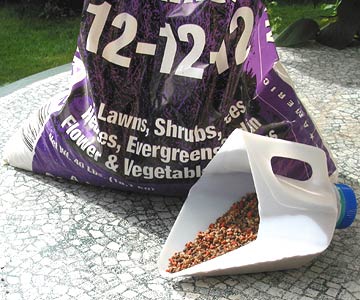
2. Or a scoop.

3. Use as a greenhouse to protect seedlings from frost.
4. Make mudguards for your bicycle.

6. Cut into circles and use as divider when freezing hamburger patties.
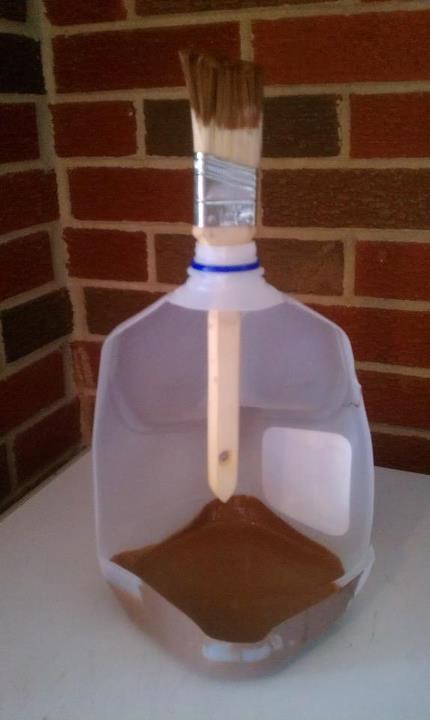
9. Pierce the bottom and use for plant irrigation.

10. Turn into an awesome Storm Trooper Helmet, just in time for Halloween.
Why I’m Not Going Pink This Month
Image by jennifrog
It’s October first, which means…Breast Cancer Awareness Month. Everything is going to be swathed in pink.
I appreciate the sentiment behind it. Women want to support other women who have been struck by this terrible illness. They want to find a cure, so their mothers, sisters, friends do not have to go through this anymore. It’s noble, to want to be a part of something bigger than yourself that can help others. When you’re battling something as ugly as cancer, or someone close to you is, you want to do whatever it takes to get rid of it.
The problem is, the pink campaign isn’t it, at least in my opinion.
The Problem With Pink
It’s become a cultural icon, that pink ribbon. It’s become a sign of strength, a sign of hope. But…is it, really?
The pink ribbon is so huge that everyone’s jumping on board. This is a problem, to me. It’s muddying the issue. It’s becoming an excuse to profit. Companies that have unhealthy products are turning out pink versions of their products so they can donate a small amount of money to a cause. KFC donated about $0.50 per bucket of chicken, which sell for around $8. More people will buy to “support a good cause” and KFC earns lots of extra money. It’s not altruism on the part of these companies.
Not to mention that these companies are not producing healthy items. MSG-laced fried chicken? Alcohol? Other junk food? It seems absolutely anything can be labeled in pink, because the name of the game is profit, not helping!
What the companies do with the money can be suspect too. I touched on that in “Why I Don’t Support Cure Cancer Foundations.”
Not Awareness, Prevention
When we’re talking about battling cancer, I think that we need to talk about the reasons why cancer occurs. In many cases, it isn’t just luck of the draw or roll of the dice. Cancer doesn’t develop “just because.” Rates have skyrocketed over the last 100 years and are now hovering around 50%. Half the population can expect to get cancer at some point in their lives!
That’s just not normal. But, we can argue that obviously, everyone is aware of cancer. Awareness is not the problem.
What we need to be talking about is prevention. Why can’t we talk about foods that increase risk…or decrease it? About using personal care products (like aluminum-containing anti-perspirants) that can increase risk? There are so many aspects of our modern day life that can increase cancer risk.
We don’t want to talk about these. We don’t want to go through the uncomfortable ideas that we might need to make some changes to keep ourselves healthier. (Yes, healthier, because nothing we do can entirely prevent illness, even cancer.) In many cases, we don’t even want to believe in these. The research isn’t conclusive. It’s too preliminary. It was poorly done. There’s no way that our modern lifestyle could possibly have anything to do with cancer rates.
That’s just sad! That’s a sad attitude. And I want to talk about it. I want to talk about how and why cancer happens, as best we know. I want to talk about what we can do to decrease our chances of getting it. I want to talk about why a healthy diet matters. Why avoiding unnecessary medicine matters. Why exercise matters. Why it all matters.
People who are close to me have had cancer. And we’ve had these conversations, privately, about what might have gone wrong. About what to do next. One of my friends beat breast cancer and did it without chemo or radiation. I want to talk about that too (in general — that cancer treatment can be non-toxic). Why can’t we talk about any of these things?
Being Real
Instead of going pink this month and trying to be part of a larger cause, full of women who mean well, I’m going to talk about the real stuff. I’m going to talk about ways to really support women, on a community level. I’m going to talk about healthy lifestyle choices that can reduce risk. I’m going to talk about what it’s been like for real women that have been through it…and come out on the other side.
Going pink just doesn’t fit in with that.
I fully understand why people support pink, especially if they or close friends or family have been through cancer. They want to help. They want to do something. They want to show support. And that’s a good thing.
I would encourage everyone to think outside of pink this month, though. Think about how to help someone in your life in a more personal way. Make them a meal, take care of their children, be their shoulder to cry on. Step outside of pink and be there.
Will you be going pink this month?
Weekend wrap-up
Just in case you don’t live your life on Facebook, here are a few fun things I shared there recently:
This made us laugh, even after we watched it 10 times. Maybe because our dog does the very same thing, and now we know what he’s saying. Our dog also talks, but he only says Mom. Now there’s one more ankle-biter following me around the house pleading, “Mom, mom, moooom, mom…”
Epic Highlights from the National Beard and Mustache Championships was awesome, but not in a I-wish-my-husband-had-facial-hair-like-this way. More in a trainwreck-can’t-stop-looking way. Awesome, nonetheless. Click the pic to see much more awesomeness.
And this, this is awesome too.
I’m already plotting to acquire it for Calvin’s upcoming birthday. I have a Plan A and Plan B. Unless Perry vetoes it, you’ll hear about Plan A soon. I’m just going to say one thing right now: Lydia put me up to it.
Oh, and I have to ask: Did you enter my giveaway? No? Do it! Yes? How many different ways? Do more!
Messy Art Day (With Recipes for Snow and Marshmallow Dough!)
Recently we had a Messy Art Day with friends. I had so many ideas for it: tie-dye t-shirts, using fall leaves to paint t-shirts, preserving leaves in melted beeswax, making fall wreaths….
Ultimately I decided against all of this. The target ages for our activity were 2 – 5, and they wouldn’t want to be told how to do a craft. They wouldn’t want to hand off parts of their creativity to adults because it was “too hard” or “too dangerous.” No, those activities are better saved for a slightly older crowd (and would be awesome for the 7 – 12 age group).
Instead I wanted to go with a bunch of different textures to explore. I wanted them to be able to get into it and not need any help playing, creating, or whatever they wanted to do.
I had some limitations. Some of our friends (with small children who like to eat play dough) are gluten-free, so white flour was out as an ingredient. I also didn’t want anything unnatural — I saw recipes with shampoo, recipes with borax, and the like — I didn’t want to go with those. I wanted basically everything to be food-like or actual food (not that I’d recommend eating these; they wouldn’t taste very good!). So I bought some ingredients and I set to work.
Snow Dough
Snow Dough is up first. I mixed this one up hoping for a sort of play-dough like outcome. It’s not really like that, other than being a thick dough. It’s similar to cloud dough. It clumps, it holds its shape, it crumbles apart easily. I was delighted with it.
The kids were intrigued, but they mostly threw it. (Good thing we were outside!) It was gone in minutes with 6 kids’ hands squishing, pushing, and throwing. Still, it would have made a neat “snow man” if they’d been more in the mood to shape. They wanted to squish, roll, and cut, and this dough isn’t so great for that.
Ingredients:
- 3 c. cornstarch
- 1 c. salt
- 8 – 10 tbsp. vegetable oil
Mix together the salt and cornstarch. Add the oil slowly, a bit at a time, especially at the end. Stir together, using your hands if necessary. Store in an air-tight container.
Marshmallow Dough
Then, I wanted something “slime like.” This would be trickier. I began to combine the ingredients, adding a bit more of this and that until it came together. Then I made a second batch to make sure I wasn’t crazy. This one I love. I wanted to play with it myself for hours. It’s thick, it sort of holds its shape, but it slides like thick liquid too. It sticks to your fingers, then slides right back off. It’s crazy. It’s perfect. It’s slime! But it looks just like marshmallow creme, hence the name.
Ingredients:
- 1/2 c. baking soda
- 1/2 c. + 2 tbsp. cornstarch
- 6 tbsp. vegetable oil
- 6 tbsp. white glue
- 1/2 c. water
Mix the baking soda and cornstarch together. Add the vegetable oil and glue and stir gently, then add the water. Keep stirring until combined. It will look a little crumbly and weird at first; keep stirring. If needed, add an extra tablespoon of cornstarch. It should be very smooth with no trace of crumble and not too much oil when it’s finished. Store in an air-tight container. It gains color easily, if mixed with paint or anything else (so you could add natural food dyes if you want, or even spinach juice or something, but it might not last as long).
The kids loved this one. They squished it, rolled it, cut it, made smiley faces in it. As I write, the kids have gone home but my daughter is turning the dough into pretend pie. My oldest son named this as his favorite activity on messy art day. It’s a hit!
Messy Art Day Activities
Our other activities included splatter painting, finger painting, mud-digging, and puff painting.
For splatter painting, I taped heavy water color paper to our back fence with masking tape, gave the kids a paper plate with dots of paint on it, and a big paint brush. I let them flick paint, throw paint, smear paint…whatever they wanted to do. Fingers were involved here too.
They spent more time actually painting the plates and our old water filter than they did the paper. Oh well. The point was to let them get into it and be creative, however they wanted to.
We’ll be doing more themed play dates over the coming months: harvest/fall crafts and food, Stone Soup day, Christmas crafts and cookies, dinosaur day, royalty day (historical), planets/space day, and lots more. We do about one per month with friends. Would you like recipes and instructions for future theme days?
This is a great way to do preschool/kindergarten homeschool! (And we have lots of reading and other learning activities on the other days, especially for the older ones.)
